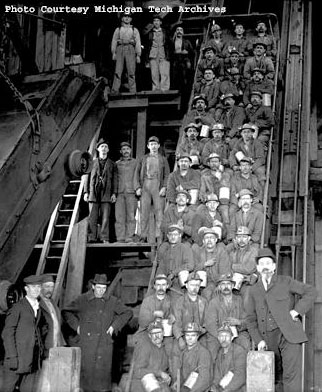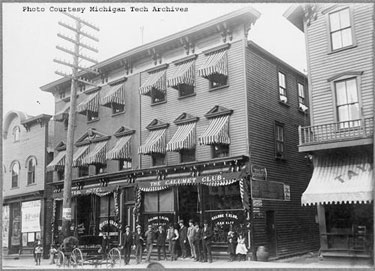|
Setting the Scene An Interior Ellis Island Keweenaw Ethnic
Groups |
This project is funded in part by Michigan Humanities Council, an affiliate of the National Endowment for the Humanities
|
Keweenaw
Ethnic Groups
~The Irish~
Abstract•••I•••Article Contents•••I•••Further Reading•••I••Image Search•••I•••Source Notes
Abstract
The Irish were present in the Lake Superior copper district from its inception (Irish 1), and by 1870 the Irish were the largest single foreign-born group, accounting for nearly a third (31.4%) of the total foreign-born population, followed by natives of England and Wales (22.2%), Canada (18.8%), and Germany (17.5%). Not only did the Irish numerically dominate the range during its early years, they also produced its greatest number of miners (Irish 2). In 1870, only the Irish and the Cornish produced more miners than laborers in the Lake Superior copper district as both ethnic groups had arrived with copper mining skills from the British Isles. Nineteenth-century Ireland had developed three large copper-mining districts: Avoca, County Wiclow, Knockmahon, County Waterford and on the Beara Peninsula in County Cork. While Irish copper miners withstood their all too often deadly work and the Great Famine, they could not withstand the parallel forces of British imperialism and global capitalism. As early as the 1820s, British smelting interests endeavored to replace Russia as the principal supplier of copper to Europe, yet their suppliers, the mines of Cornwall and Ireland, could not even supply the British domestic demand (Irish 3). In 1842 the British Government attempted to alleviate the supply problem by reducing the tariff on foreign copper by half. British capital responded by investing heavily in the development of copper mines in the New World. Thus, a combination of state action and the subsequent capital flight resulted in the decline of Cornish and Irish copper mines and the rise of copper mining in the New World (Irish 4). During the 1850's and 1860's Irish mines closed and many unemployed miners migrated to America in search of work. Joining these unemployed copper miners in their migration, of course, were millions other of other Irish emigrants who could no longer sustain themselves on the land. In the years after the Great Famine, Irish agriculture underwent a shift from tillage farming to pasture farming, or grazing cattle, which was considerable less labor intensive. As such, hundreds of thousands of agricultural laborers were without work and were forced to emigrate. While many of these unskilled Irish laborers made their way to Michigan’s Copper Country, the majority of the Irish on the Keweenaw Range migrated from Irish mining districts. There existed a well-defined chain migration from the copper mines of Knockmahon in County Waterford and a particularly strong chain migration from the mines on the Beara Peninsula in County Cork. In the Copper Country, the Irish and Cornish experienced a contentious relationship, which may have originated in the Irish copper districts (Irish 5). Indeed, most histories of hard-rock mining refer to Irish miners only within the context of their relationship with Cornish miners. Willis Dunbar's Michigan: a History of the Wolverine State, the standard text of a generation ago, mentioned Irish copper miners only twice. In the first instance, Dunbar noted, "Antagonism between the Cornishmen, or 'Cousin Jacks,' and the Irish in mining towns became traditional (Irish 6)." In the second, Dunbar quipped, "The Irish, nicknamed 'Micks,' were about as numerous in the Copper Country as the Cousin Jacks. And there was a traditional rivalry between the two (Irish 7)." Most histories have explained this "traditional rivalry" in terms of ethnic bigotry (Irish 8). A more historically accurate explanation of this rivalry, however, was labor-market competition, and a competition that was ethnicized, as both ethnic groups competed for the skilled position of miner. Given that ethnicity is a relationship, the percent of an ethnic group, not simple numbers, often determines a community’s ethnic dimension and a specific ethnic group’s position within it. In 1870 the Irish accounted for 17.8% of Houghton County's total population (Irish 9), making Houghton County, by percent of population born in Ireland, the sixth most Irish county in the United States (Irish 10). The Lake Superior copper district was in many ways a predecessor for Butte, Montana, which historians of Irish America often term the most Irish city in America, even though it contained, of course, far fewer Irish than New York, Boston, Philadelphia or Chicago. After 1870 in Houghton County, the foreign born Irish declined in both actual numbers and in their percentage of the total foreign born. By 1880 Cornish and French Canadians surpassed the Irish. During the 1880s the Finns, Germans, Norwegians, and Swedes also exceeded the Irish. At the close of the century, among the foreign-born of Houghton County, the Irish ranked only seventh. While the number of first-generation Irish dropped dramatically from 1870-1900, as did their percentage of the foreign-born population, many second-generation Irish Americans presumably followed their initial numerical strength on the Keweenaw range. Some of these Irish Americans, however, clearly did not remain on the Keweenaw range, as according to the U.S. Census, Michigan was the most frequent state of birth among Butte's second-generation Irish (Irish 11). Most likely, the majority of these Michigan-born second-generation Irish in Butte had migrated from the Keweenaw Peninsula with their Irish-born parents.
In the Copper Country, as did in the throughout United States, the Ancient Order of Hibernians (AOH) emerged as the largest Irish-American fraternal organization. The AOH established divisions in Hancock, Calumet, Laurium, Dollar Bay, and Lake Linden (Irish 13). The Michigan Hibernian presented a glimpse of the 1907 St. Patrick’s Day celebrations in the Copper Country. The members of the Calumet AOH division assembled in their hall at 8:00 am and marched to Laurium where they were meet by the Laurium division. Both divisions then attended a 9:00 am Mass at Sacred Heart Church. In the afternoon, a special train on the Copper Range Railroad brought the AOH divisions from Hancock, Dollar Bay, and Lake Linden to Calumet. These divisions had spent the morning at Mass and parading through their communities. When all five divisions arrived in Calumet, the seven hundred plus Hibernians marched en masse through Calumet’s principal streets, concluding at the town hall where they heard speeches from prominent Hibernians. In the evening, they attended a dinner, which was followed by a theatrical play (Irish 14).
The 1909 Report of Immigration Commission offers a statistical portrait of an established and aging Irish immigrant community in the Copper Country. The most striking feature of the report was the high percent of Irish workers whose wives had died. The report highlighted the fact that “None of the South Italians or Poles and less than 1 per cent of the North Italians and Slovenians are widowed, but 22.5 percent of Irish males are that condition (Irish 17).” The high percentage of Irish widowers might be partially explained by the advanced age of the foreign-born Irish workers. Where as only 13% of the entire workforce was 45 years of age or older, 70% of the foreign-born Irish workers were 45 years of age or older, with a third being 55 years of age or older (Irish 18). Reflecting, perhaps, their early migration to the Copper Country, 78% of both the foreign-born Irish and German workers had lived in the United States for 20 years or more, compared to only 19% of the entire foreign-born workforce (Irish 19). By 1909, two-third of Irish surveyed were native born, the highest percent of any ethnic group. Indeed, only the Irish (66%), the Germans (62%) and the Scots (55%) had more second-generation ethnics than immigrants in their working communities. This is most striking when compared to other ethnic groups: French-Canadians (44%), Norwegians (43%), Cornish (24%), Swedes (1%) and Finns (>1%) (Irish 20). Given their time on the range, their relative position of privilege, and the proportion of second generation Irish, it is not entirely surprising that the Irish had the highest average family income in the Copper Country (Irish 21). While their early arrival on the range contributed to the high percent of second-generation Irish within the larger Irish community, a greater factor was the dramatic decrease in Irish immigrants selecting the Copper Country after 1880. Clearly, most Irish copper miners preferred Butte. As mentioned previously, with the tremendous immigration of other ethnic groups, the Irish as a percent of the population and workforce precipitously declined. This is reflected in the employment records of the Quincy Mining Company. In the 1890s, the Irish (both immigrants and second generation) accounted for 9% of Quincy’s hires. During the decade from 1900 to 1909, even though one-third of the native born hired were Irish, their percent of hired dropped to 5% and from 1910 to 1919, to just 2% (Irish
22). By the time of the July 1913 Strike, the Irish accounted for about 4% of Calumet and Hecla’s underground workforce (Irish
23). C&H records also reveal that when it attempted to resume operations in September 1913, 24% Irish refused to return to work. Their support for the strike, if measured by their refusal to return to work, was well below the company average of 40%. Yet, their support for the strike, again if measured by refusal to return to work, was the greatest among the old immigrant groups: Cornish (11%), Germans (16%) and the Scandinavians (19%) (Irish
24).
Further Reading Kevin Kenny, The American Irish: A History, New York: Longman, 2000. Timothy O’Neil, "Miners in Migration: The Case of Nineteenth-Century Irish and Irish American Copper Miners," in New Directions in Irish American History, Kevin Kenny, ed., Madison: University of Wisconsin Press, 2003. David Emmons, The Butte Irish: Class and Ethnicity in an American Mining Town, 1875-1925, Chicago: University of Illinois Press, 1989. William H. Mulligan, “Irish Immigrants in Michigan’s Copper Country,” New Hibernia Review, 5:4 (Winter 2001), 109-122.
|
Copyright © 2004 - 2007
MTU Archives and Copper Country Historical Collections, J. Robert
Van Pelt Library, All Rights Reserved |




